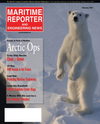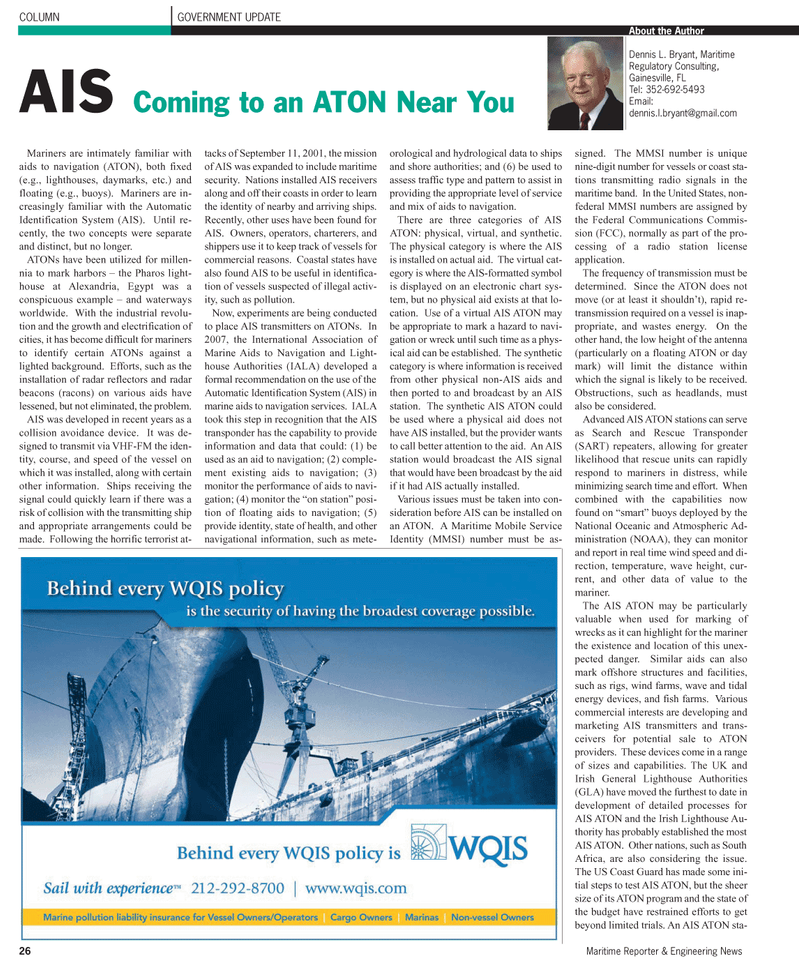
Page 26: of Maritime Reporter Magazine (February 2011)
Cruise & Passenger Vessel Annual
Read this page in Pdf, Flash or Html5 edition of February 2011 Maritime Reporter Magazine
Mariners are intimately familiar with aids to navigation (ATON), both fixed (e.g., lighthouses, daymarks, etc.) and floating (e.g., buoys). Mariners are in- creasingly familiar with the Automatic
Identification System (AIS). Until re- cently, the two concepts were separate and distinct, but no longer.
ATONs have been utilized for millen- nia to mark harbors – the Pharos light- house at Alexandria, Egypt was a conspicuous example – and waterways worldwide. With the industrial revolu- tion and the growth and electrification of cities, it has become difficult for mariners to identify certain ATONs against a lighted background. Efforts, such as the installation of radar reflectors and radar beacons (racons) on various aids have lessened, but not eliminated, the problem.
AIS was developed in recent years as a collision avoidance device. It was de- signed to transmit via VHF-FM the iden- tity, course, and speed of the vessel on which it was installed, along with certain other information. Ships receiving the signal could quickly learn if there was a risk of collision with the transmitting ship and appropriate arrangements could be made. Following the horrific terrorist at- tacks of September 11, 2001, the mission of AIS was expanded to include maritime security. Nations installed AIS receivers along and off their coasts in order to learn the identity of nearby and arriving ships.
Recently, other uses have been found for
AIS. Owners, operators, charterers, and shippers use it to keep track of vessels for commercial reasons. Coastal states have also found AIS to be useful in identifica- tion of vessels suspected of illegal activ- ity, such as pollution.
Now, experiments are being conducted to place AIS transmitters on ATONs. In 2007, the International Association of
Marine Aids to Navigation and Light- house Authorities (IALA) developed a formal recommendation on the use of the
Automatic Identification System (AIS) in marine aids to navigation services. IALA took this step in recognition that the AIS transponder has the capability to provide information and data that could: (1) be used as an aid to navigation; (2) comple- ment existing aids to navigation; (3) monitor the performance of aids to navi- gation; (4) monitor the “on station” posi- tion of floating aids to navigation; (5) provide identity, state of health, and other navigational information, such as mete- orological and hydrological data to ships and shore authorities; and (6) be used to assess traffic type and pattern to assist in providing the appropriate level of service and mix of aids to navigation.
There are three categories of AIS
ATON: physical, virtual, and synthetic.
The physical category is where the AIS is installed on actual aid. The virtual cat- egory is where the AIS-formatted symbol is displayed on an electronic chart sys- tem, but no physical aid exists at that lo- cation. Use of a virtual AIS ATON may be appropriate to mark a hazard to navi- gation or wreck until such time as a phys- ical aid can be established. The synthetic category is where information is received from other physical non-AIS aids and then ported to and broadcast by an AIS station. The synthetic AIS ATON could be used where a physical aid does not have AIS installed, but the provider wants to call better attention to the aid. An AIS station would broadcast the AIS signal that would have been broadcast by the aid if it had AIS actually installed.
Various issues must be taken into con- sideration before AIS can be installed on an ATON. A Maritime Mobile Service
Identity (MMSI) number must be as- signed. The MMSI number is unique nine-digit number for vessels or coast sta- tions transmitting radio signals in the maritime band. In the United States, non- federal MMSI numbers are assigned by the Federal Communications Commis- sion (FCC), normally as part of the pro- cessing of a radio station license application.
The frequency of transmission must be determined. Since the ATON does not move (or at least it shouldn’t), rapid re- transmission required on a vessel is inap- propriate, and wastes energy. On the other hand, the low height of the antenna (particularly on a floating ATON or day mark) will limit the distance within which the signal is likely to be received.
Obstructions, such as headlands, must also be considered.
Advanced AIS ATON stations can serve as Search and Rescue Transponder (SART) repeaters, allowing for greater likelihood that rescue units can rapidly respond to mariners in distress, while minimizing search time and effort. When combined with the capabilities now found on “smart” buoys deployed by the
National Oceanic and Atmospheric Ad- ministration (NOAA), they can monitor and report in real time wind speed and di- rection, temperature, wave height, cur- rent, and other data of value to the mariner.
The AIS ATON may be particularly valuable when used for marking of wrecks as it can highlight for the mariner the existence and location of this unex- pected danger. Similar aids can also mark offshore structures and facilities, such as rigs, wind farms, wave and tidal energy devices, and fish farms. Various commercial interests are developing and marketing AIS transmitters and trans- ceivers for potential sale to ATON providers. These devices come in a range of sizes and capabilities. The UK and
Irish General Lighthouse Authorities (GLA) have moved the furthest to date in development of detailed processes for
AIS ATON and the Irish Lighthouse Au- thority has probably established the most
AIS ATON. Other nations, such as South
Africa, are also considering the issue.
The US Coast Guard has made some ini- tial steps to test AIS ATON, but the sheer size of its ATON program and the state of the budget have restrained efforts to get beyond limited trials. An AIS ATON sta- 26 Maritime Reporter & Engineering News
COLUMN GOVERNMENT UPDATE
AIS Coming to an ATON Near You
About the Author
Dennis L. Bryant, Maritime
Regulatory Consulting,
Gainesville, FL
Tel: 352-692-5493
Email: [email protected]

 25
25

 27
27
